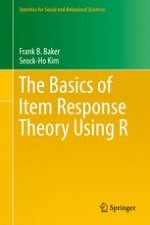2017 | OriginalPaper | Buchkapitel
7. Test Calibration
verfasst von : Frank B. Baker, Seock-Ho Kim
Erschienen in: The Basics of Item Response Theory Using R
Aktivieren Sie unsere intelligente Suche, um passende Fachinhalte oder Patente zu finden.
Wählen Sie Textabschnitte aus um mit Künstlicher Intelligenz passenden Patente zu finden. powered by
Markieren Sie Textabschnitte, um KI-gestützt weitere passende Inhalte zu finden. powered by
